Submitted:
31 October 2023
Posted:
31 October 2023
You are already at the latest version
Abstract
Keywords:
1. Introduction

1.1. Background Development of SEM
1.2. Basic SEM Operation
1.2.1. Specimen Preparation
1.2.2. Imaging Process in the SEM
1.3. Fundamental Theoretical Calculations
2. Scanning Electron Microscopy and Mineral Characterization
2.1. SEM Energy Dispersive X-Ray Spectroscopy (SEM-EDS)
2.2. SEM-Based Automated Mineralogy (SEM-AM)
2.3. Automated SEM Mineral Liberation Analysis (SEM-MLA)
2.4. Quantitative Evaluation of Minerals by Scanning Electron Microscopy (QEMSCAN)
| Investigation | Electron microprobe | XRD | QEMSCAN |
| Mineral textures | (✔) | ● | ✔✔✔ |
| Mineral distributions and associations | (✔) | ● | ✔✔ |
| Mineral specific particle size information | (✔) | ● | ✔✔ |
| Mineral abundances | ● | ✔✔✔ | ✔✔✔ |
| Amorphous minerals (geothite, silica) | ✔✔✔ | ● | ✔✔✔ |
| Distribution of minor metals within minerals | ✔✔✔ | ● | ✔ |
| Crystallinity (clays, silica, geothite, and limonite) | ● | ✔✔✔ | ● |
3. Uncertainties in SEM Measurements
3.1. Constraints in Phase Identification by EDS Spectra
3.2. Sample Preparation and Related Issues
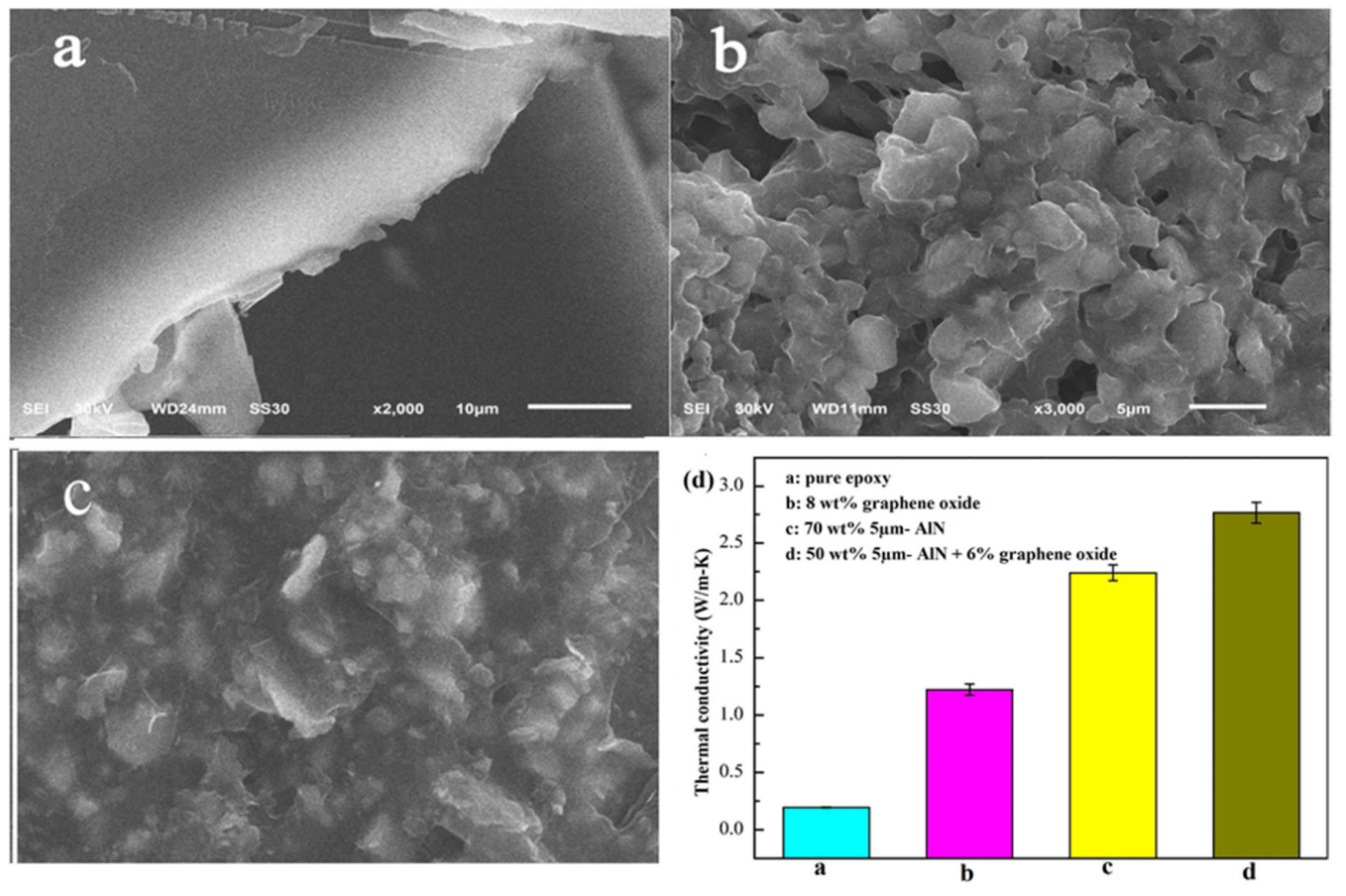
| Sample | Layer | Sputter Coating |
| A | Multiple | Applied |
| B | Single | Applied |
| C | Single | Not Applied |
4. Future Research and Directions
5. Conclusion
Author Contributions
Funding
Data Availability Statement
Acknowledgments
Conflicts of Interest
Nomenclature
| BSE | Backscattered electron |
| BSEI | Backscattered electron imaging |
| CLI | Cathodoluminescence imaging |
| CSEM | Conventional scanning electron microscopy |
| EBIC | Electron beam induced current |
| EBD | Electron backscatter diffraction |
| EDS | Energy dispersive X-ray spectroscopy |
| ESEM | Environmental scanning electron microscopy |
| FEG SEM | Field emission gun scanning electron microscopy |
| LVSEM | Low vacuum scanning electron microscopy |
| LM | Light microscopy |
| MLA | Mineral liberation analysis |
| OM | Optical microscopy |
| PXMAP | Particle X-ray mapping |
| QEMSCAN | Quantitative evaluation of minerals by scanning electron microscopy |
| RPS | Rare phase search |
| SEI | Secondary electron imaging |
| SEM | Scanning electron microscopy |
| SPL | Sparse phase liberation analysis |
| SXMAP | Selected particle X-ray mapping |
| TEM | Transmission electron microscopy |
| VCI | Voltage contrast imaging |
| XBSE | Extended BSE liberation analysis |
| XRD | X-ray diffraction |
| XMOD | X-ray modal analysis |
References
- RRUFF - Minerals database. https://rruff.info/.
- R M Hazen, D Papineau, W Bleeker, et al. Mineral evolution. American Mineralogist 2008, 93, 1693-1720. [CrossRef]
- C R Clarkson, M Freeman, L He, et al. Characterization of tight gas reservoir pore structure using USANS/SANS and gas adsorption analysis. Fuel 2012, 95(1), 371-385. [CrossRef]
- X Yu, S Li, Z Yang. Discussion on deposition-diagenesis genetic mechanism and hot issues of tight sandstone gas reservoir. Lithologic Reservoirs 2015, 27(1), 1-13. [CrossRef]
- X Sui, M M Bustin, R M Bustin. Measurement of gas permeability and diffusivity of tight reservoir rocks: different approaches and their applications. Geofluids 2009, 9(3), 208-223. [CrossRef]
- T Saif, Q Lin, A R Butcher, et al. Multi-scale multi-dimensional microstructure imaging of oil shale pyrolysis using X-ray micro-tomography, automated ultra-high resolution SEM, MAPS mineralogy, FIB-SEM. Applied Energy 2017, 202, 628-647. [CrossRef]
- R D Pascoe, M R Power, B Simpson. QEMSCAN analysis as a tool for improved understanding of gravity separator performance. Minerals Engineering 2007, 20(5), 487-495. [CrossRef]
- J L Antoniassi, D Uliana, R Contessotto, et al. Process mineralogy of rare earths from deeply weathered alkali-carbonatite deposits in Brazil. Journal of Materials Research and Technology 2020, 9(4), 8842-8853. [CrossRef]
- L Ji, J Qiu, Y Q Xia, et al. Micro-pore characteristics and methane adsorption properties of common clay minerals by electron microscope scanning. Acta Petrolie Sinica 2012, 33(2), 249-256. [CrossRef]
- B Allard, C Sotin. Determination of mineral phase percentage in granular rocks by image analysis on a microcomputer. Computer & Geosciences 1988, 14(2), 261-269. [CrossRef]
- K D Vernon-Parry. Scanning electron microscopy: an introduction. III-Vs Review 2000, 13(4), 40-44. [CrossRef]
- M Winey, J B Meehl, E T O’toole, et al. Conventional transmission electron microscopy. Molecular Biology of the Cell 2017, 25(3). [CrossRef]
- K C A Smith, C W Oatley. The scanning electron microscope and its fields of application. British Journal of Applied Physics 1955, 6(391). [CrossRef]
- C Teng, Y Yuan, R Gauvin. The f-ratio quantification method applied to standard minerals with a cold field emission SEM/EDS. Talanta 2019, 204, 213-223. [CrossRef]
- S Ellingham, T J U Thompson, M Islam. Scanning electron microscopy-energy-dispersive x-ray (SEM/EDX): A rapid diagnostic tool to aid the identification of burnt bones and contested cremains. Journal of Forensic Sciences 2017, 63(3). [CrossRef]
- C Jiang, H Lu, H Zhang, et al. Recent advances on in situ SEM mechanical and electrical characterization of low-dimensional nanomaterials. Scanning 2017, 1985149, 11. [CrossRef]
- S Picazo, B Malvoisin, L Baumgartner, et al. Low temperature serpentine replacement by carbonates during seawater influx in the newfoundland margin. Minerals 2020, 10(2), 184. [CrossRef]
- H G Machel, R A Mason, A N Mariano, et al. Causes and emission of luminescence in calcite and dolomite. Luminescence Microscopy and Spectroscopy: Qualitative and Quantitative Applications 1991. [CrossRef]
- Erol A. High-magnification SEM micrograph of siloxanes. Atomic Force Microscopy and Its Applications 2018. [CrossRef]
- H Sato, M O-Hori, K Nakayama. Surface roughness measurement by scanning electron microscope. CIRP Annals 1982, 31(1), 457-462. [CrossRef]
- P Viswanathan, M G Ondeck, S Chirasatitsin, et al. 3D surface topology guides stem cell adhesion and differentiation. Biomaterials 2015, 52, 140-147. [CrossRef]
- J Wu, L Wang, L Meng. Analysis of mineral composition and microstructure of gravel aggregate based on XRD and SEM. Road Materials and Pavement Design 2017, 18, 139-148. [CrossRef]
- W Zhou, H F Greer. What can electron microscopy tell us beyond crystal structures. European Journal of Inorganic Chemistry (EurJIC) 2016, 7, 941-950. [CrossRef]
- J A Tyburczy. Properties of rock and minerals - The electrical conductivity of rocks, minerals, and the earth. Treatise on Geophysics 2007, 2, 631-642. [CrossRef]
- J D Bonilla-Jaimes, J A H Martínez, C M Luna, et al. Non-destructive in situ analysis of garnet by combining scanning electron microscopy and x-ray diffraction techniques. DYNA 2016, 83(195), 84. [CrossRef]
- W L Sarney. Sample preparation procedure for TEM imaging of semiconductor materials. Army Research Laboratory 2004, ARL-TR-3223. https://apps.dtic.mil/sti/pdfs/AD1111666.pdf.
- C Habold, S Dunel-Erb, C Chevalier, et al. Observations of the intestinal mucosa using environmental scanning electron microscopy (ESEM); comparison with conventional scanning electron microscopy (CSEM). Micron 2003, 34(8), 373-379. [CrossRef]
- G Danilatos, J Rattenberger, V Dracopoulos. Beam transfer characteristics of a commercial environmental SEM and a low vacuum SEM. Journal of Microscopy 2010, 242(2), 166-180. [CrossRef]
- T J Van Dam. L L Sutter, K D Smith, et al. Guidelines for detection, analysis, and treatment of materials-related distress in concrete pavements. Federal Highway Administration, Research Technology and Development, Virginia 2002, 2, 246. https://rosap.ntl.bts.gov/view/dot/808.
- M B Haha, E Gallucci, A Guidoum, et al. Relation of expansion due to alkali silica reaction to the degree of reaction measured by SEM image analysis. Cement and Concrete Research 2007, 37(8), 1206-1214. [CrossRef]
- S Zebbar, D Zebbar, A Kadoun. Gaseous cascade amplification in He-H2O gas mixture in an environmental scanning electron microscope. Energy Procedia 2015, 74, 205-210. [CrossRef]
- M Knoll, E Ruska. Das Elektronenmikroskop. Zeitschrift für Physik 1932, 78, 318-339. https://link.springer.com/article/10.1007/BF01342199. [CrossRef]
- E Ruska. The development of the electron microscope and of electron microscopy. Bioscience Reports 1987, 7, 607-629. https://link.springer.com/article/10.1007/BF01127674. [CrossRef]
- M von Ardenne. Das Elektronen-Rastermikroskop. Zeitschrift für Physik 1938, 109, 553-572. https://link.springer.com/article/10.1007/BF01341584. [CrossRef]
- M von Ardenne, P Hawkes, T Mulvey. On the history of scanning electron microscopy, of the electron microprobe, and of early contributions to transmission electron microscopy. Advances in Imaging and Electron Physics 2021, 220, 25-50. [CrossRef]
- J I Goldstein, D E Newbury, P Echlin, et al. Scanning electron microscopy and X-ray microanalysis. Kluwer Academic, New York 2003. ISBN: 978-1-4613-4969-3.
- P J Breton. From microns to nanometers: Early landmarks in the science of scanning electron microscope imaging. Scanning Microscopy 1999, 13(1). Link.
- G D Danilatos. Review and outline of environmental SEM at present. Journal of Microscopy 1991, 391-402. [CrossRef]
- G D Danilatos. Introduction to the ESEM instrument. Microscopy Research & Technique 1993, 25, 354-361. [CrossRef]
- H Li, J Li, G Gu. Local field emission from individual vertical carbon nanofibers grown on tungsten filament. Carbon 2005, 43(4), 849-853. [CrossRef]
- C W Oatley. The tungsten filament gun in the scanning electron microscope. Journal of Physics E: Scientific Instruments 1975, 8, 1037. [CrossRef]
- H Ahmed, A N Broers. Lanthanum hexaboride electron emitter. Journal of Applied Physics 1972, 43(5), 2185-2192. [CrossRef]
- J M D Kowalczyk, M R Hadmack, E B Szarmes, et al. Emissivity of lanthanum hexaboride thermionic electron gun cathode. International Journal of Thermophysics 2014, 35, 1538-1544. https://link.springer.com/article/10.1007/s10765-014-1712-3. [CrossRef]
- T C Isabell, V P Dravid. Resolution and sensitivity of electron backscattered diffraction in a cold field emission gun SEM. Utramicroscopy 1997, 67, 59-68. [CrossRef]
- M A Harmann, S Blouin, B M Misof, et al. Quantitative backscattered electron imaging of bone using a thermionic or a field emission electron source. Calcified Tissue International 2021, 109, 190-202. https://link.springer.com/article/10.1007/s00223-021-00832-5. [CrossRef]
- K de Haan, Z S Ballard, Y Rivenson, et al. Resolution enhancement in scanning electron microscopy using deep learning. Scientific Reports 2019, 9, 12050. https://www.nature.com/articles/s41598-019-48444-2. [CrossRef]
- M Ramakokovhu, P A Olubambi, R K Mbaya, et al. Mineralogical and leaching characteristics of altered ilmenite beach placer sands. Minerals 2020, 10(11), 1022. [CrossRef]
- G T Belz, G J Auchterlonie. An investigation of the use of chromium, platinum and gold coating for scanning electron microscopy of casts of lymphoid tissues. Micron 1995, 26(2), 141-144. [CrossRef]
- A L Volynskii, D A Panchuk, A V Bolshakova, et al. Structure and properties of nanosized coatings deposited onto polymers. Colloid Journal 2011, 73(5), 587-604. [CrossRef]
- I Stokroos, D Kalicharan, J J V D Want, et al. A comparative study of thin coatings of Au/Pd, Pt and Cr produced by magnetron sputtering for FE-SEM. Journal of Microscopy 1998, 189, 79-89. [CrossRef]
- A Agarwal, J Simonaitis, V K Goyal, et al. Secondary electron count imaging in SEM. Ultramicroscopy 2023, 245, 113662. [CrossRef]
- P Kejzlar, M Švec, E Macajová. The usage of backscattered electrons in scanning electron microscopy. Manufacturing Technology 2014, 14(3), 333-336. [CrossRef]
- E Sánchez, M Torres Deluigi, G Castellano. Mean atomic number quantitative assessment in backscattered electron imaging. Microscopy and Microanalysis 2012, 18(6). [CrossRef]
- E Müller, D Gerthsen. Composition quantification of electron-transparent samples by backscattered electron imaging in scanning electron microscopy. Ultramicroscopy 2017, 173, 71-75. [CrossRef]
- M Čalkovský, E Müller, D Gerthsen. Quantitative analysis of backscattered-electron contrast in scanning electron microscopy. Journal of Microscopy 2022, 289(1), 32-47. [CrossRef]
- L Reimer. Scanning electron microscopy. Springer series in optical science 1985, 42. Link.
- E Palamara, P P Das, S Nicolopoulos, et al. Applying SEM-cathodoluminescence imaging and spectroscopy as an advanced research tool for the characterization of archaeological material. Microchemical Journal 2020, 158, 105230. [CrossRef]
- C M Parish, D Batchelor, C Progl, et al. Electron beam induced current in SEM. Materials Characterization Department: Sandia National Laboratories 2007. Link.
- K Suemori, Y Watanabe, N Fukuda, et al. Voltage contrast in scanning electron microscopy to distinguish conducting Ag nanowire networks from nonconducting Ag nanowire networks. ACS Omega 2020, 5(22), 12692-12697. [CrossRef]
- A V Crewe, M Isaacson, D Johnson. A simple scanning electron microscope. Review of Scientific Instruments 1969, 123081517. [CrossRef]
- C Li, D Wang, L Kong. Application of machine learning techniques in mineral classification for scanning electron microscopy - energy dispersive X-ray spectroscopy (SEM-EDS) images. Journal of Petroleum Sciences and Engineering 2021, 200, 108178. [CrossRef]
- Y Wen, Y Cheng, Z Liu, et al. Application of SEM and EDS for mineral composition of shale gas reservoir. IOP Conference Series: Materials Science and Engineering 2020, 780, 042055. [CrossRef]
- W Nikonow, D Rammlmair. Automated mineralogy based on micro-energy-dispersive X-ray fluorescence microscopy (µ-EDXRF) applied to plutonic rock thin sections in comparison to a mineral liberation analyzer. Geoscientific Instrumentation, Methods and Data Systems 2017, 6(2), 429-437. [CrossRef]
- G Pe-Piper, A Imperial, D J W Piper, et al. Mineral data (SEM, electron microprobe, Raman spectroscopy) from epithermal hydrothermal alteration of the Miocene Sigri Petrified Forest and host pyroclastic rocks, Western Lesbos, Greece. Data in Brief 2019, 24, 103987. [CrossRef]
- R M Santos, P C M Knops, K L Rijnsburger, et al. CO2 energy reactor - integrated mineral carbonation: Perspectives on lab-scale investigation and products valorization. Frontiers in Energy Research 2016, 4. [CrossRef]
- K Lammers, R Murphy, A Riendeau, et al. CO2 sequestration through mineral carbonation of iron oxyhydroxides. Environmental Science & Technology 2011, 45, 10422-10428. [CrossRef]
- F Haque, R M Santos, Y W Chiang. Using nondestructive techniques in mineral carbonation for understanding reaction fundamentals. Powder Technology 2019, 357, 134-138. [CrossRef]
- A E Zarandi, F Larachi, G Beaudoin, et al. Nesquehonite as a carbon sink in ambient mineral carbonation of ultramafic mining wastes. Chemical Engineering Journal 2017, 314, 160-168. [CrossRef]
- H Fantucci, J S Sidhu, R M Santos. Mineral carbonation as an educational investigation of green chemical engineering design. Sustainability 2019, 11(15), 4156. [CrossRef]
- A Ali, Y Wai Chiang, R M Santos. X-ray diffraction techniques for mineral characterization: A review for engineers of the fundamentals, applications, and research directions. Minerals 2022, 12(2), 205. [CrossRef]
- H P Klug, L E Alexander. X-ray diffraction procedures: For polycrystalline and amorphous materials, 2nd edition. Wiley 1974. ISBN: 978-0-471-49369-3.
- A Ali, C E Mendes, L G T C de Melo, et al. Production of sodium bicarbonate with saline brine and CO2 co-utilization: comparing modified Solvay approaches. Crystals 2023, 13(3), 470. [CrossRef]
- G C Chi, G Xiao, Y L Chen, et al. Application of X-ray powder diffractometer in the identification and classification of phyllite. Geology and Resources 2013, 22(5), 409-414. [CrossRef]
- Z Xue-hua. Controlling factors of order degree of dolomite in carbonate rocks: A case study from lower palezoic in Tahe oilfield and Triassic in northeastern Sichuan basin. Lithologic reservoirs 2009, 21(3), 50-55. Link.
- M J Trindade, M I Dias, J Coroado, et al. Mineralogical transformations of calcareous rich clays with firing: A comparative study between calcite and dolomite rich clays from Algrave, Portugal. Applied Clay Science 2009, 42, 345-355. [CrossRef]
- M Dri, A Sanna, M M Maroto-Valer. Mineral carbonation from metal wastes: Effect of solid to liquid ratio on the efficiency and characterization of carbonated products. Applied Energy 2014, 113, 515-523. [CrossRef]
- B Reynolds, K J Reddy, M D Argyle. Field application of accelerated mineral carbonation. Minerals 2014, 4, 191-207. [CrossRef]
- D E Newbury, N W M Ritchie. Is scanning electron microscopy/energy dispersive x-ray spectrometry (SEM/EDS) quantitative? Scanning 2013, 35, 141-168. [CrossRef]
- M Warlo, C Wanhainen, G Bark, et al. Automated quantitative mineralogy optimized for simultaneous detection of (precious/critical) rare metals and base metals in a production-focused environment. Minerals 2019, 9(7), 440. [CrossRef]
- B Schulz, D Sandmann, S Gilbricht. SEM-based automated mineralogy and its application in geo- and material sciences. Minerals 2020, 10(11), 1004. [CrossRef]
- B Schulz, G Merker, J Gutzmer. Automated SEM mineral liberation analysis (MLA) with generically labelled EDX spectra in the mineral processing of rare earth element ores. Minerals 2019, 9(9), 527. [CrossRef]
- D M Smythe, A Lombard, L L Coetzee. Rare earth element deportment studies utilising QEMSCAN technology. Minerals Engineering 2013, 52, 52-61. [CrossRef]
- G K Rollinson, J C Andersen, R J Stickland, et al. Characterisation of non-sulphide zinc deposits using QEMSCAN®. Minerals Engineering 2011, 24, 778-787. [CrossRef]
- C Knappett, D Pirrie, M R Power. Mineralogical analysis and provenancing of ancient ceramics using automated SEM-EDS analysis (QEMSCAN®): A pilot study on LB I pottery from Akrotiri, Thera. Journal of Archaeological Science 2011, 38, 219-232. [CrossRef]
- M A Saghiri, K Asgar, M Lotfi, et al. Back-scattered and secondary electron images of scanning electron microscopy in dentistry: a new method of surface analysis. Acta Odontologica Scandinavica 2012, 70(6), 603-609. [CrossRef]
- K O Kjellsen, A Monsøy, K Isachsen, et al. Preparation of flat-polished specimens for SEM-backscattered electron imaging and X-ray microanalysis - importance of epoxy impregnation. Cement and Concrete Research 2003, 33(4), 611-616. [CrossRef]
- P Kejzlar, M Švec, E Macajová. The usage of backscattered electrons in scanning electron microscopy. Manufacturing Technology 2014, 14(3), 333-336. [CrossRef]
- K F J Heinrich, H Yakowitz. Quantitative electron probe microanalysis: Fluorescence correction uncertainty. Microchimica Acta 1968, 56, 905-916. [CrossRef]
- Z-S Duma, T Sihvonen, J Havukainen, et al. Optimizing energy dispersive X-ray spectroscopy (EDS) image fusion to scanning electron microscopy (SEM) images. Micron 2022, 163, 103361. [CrossRef]
- M Scimeca, S Bischetti, H K Lamsira, et al. Energy dispersive X-ray (EDX) microanalysis: A powerful tool in biomedical research and diagnosis. European Journal of Histochemistry 2018, 62(1), 2841. [CrossRef]
- B G Kutchko, A G Kim. Fly ash characterization by SEM-EDS. Fuel 2006, 85, 2537-2544. [CrossRef]
- F Georget, W Wilson, K L Scrivener. Microstructure characterization from quantified SEM-EDS hypermaps. Cement and Concrete Research 2021, 141, 106327. [CrossRef]
- E J Vermeij, P D Zoon, S B C G Chang, et al. Analysis of microtraces in invasive traumas using SEM/EDS. [CrossRef]
- A V Girao, G Caputo, M C Ferro. Application of scanning electron microscopy-energy dispersive X-ray spectroscopy (SEM-EDS). Comprehensive Analytical Chemistry 2017, 75, 153-168. [CrossRef]
- A Avula, A Galor, P Blackwelder, et al. Application of scanning electron microscopy with energy dispersive X-ray spectroscopy for analyzing ocular surface particles on schirmer strips. Cornea 2017, 36(6), 752-756. [CrossRef]
- S Han, S C Löhr, A N Abbott, et al. Earth system science applications of next-generation SEM-EDS automated mineral mapping. Frontiers in Earth Science 2022, 10. [CrossRef]
- D Moro, G Ulian, G Valdrè. SEM-EDS nanoanalysis of mineral composite materials: A Monte Carlo approach. Composite Structures 2021, 259, 113227. [CrossRef]
- A Butera, M Pascadopoli, S Gallo, et al. SEM/EDS evaluation of the mineral deposition on a polymeric composite resin of a toothpaste contacting biomimetic Zn-carbonate hydroxyapatite (microRepair®) in oral environment: A randomized clinical trial. Polymers 2021, 13(16), 2740. [CrossRef]
- Y Liu, A Liu, S Liu, et al. Nano-scale mechanical properties of constituent minerals in shales investigated by combined nanoindentation statistical analyses and SEM-EDS-XRD techniques. International Journal of Rock Mechanics and Mining Sciences 2022, 159, 105187. [CrossRef]
- S Sukmara, Suyanti, W A Ardi, et al. Mineral analysis and its extraction process of ilmenite rocks in titanium-rich cumulates from Pandeglang Banten Indonesia. Journal of Materials Research and Technology 2022, 17, 3384-3393. [CrossRef]
- A T Weerakoon, C Cooper, I A Meyers, et al. Does dentine mineral change with anatomical location, microscopic site and patient age? Journal of Structural Biology: X 2022, 6, 10060. [CrossRef]
- Y Jiang, Y Li, S Liao, et al. Mineral chemistry and 3D tomography of a Chang’E 5 high-Ti basalt: implication for the lunar thermal evolution history. Science Bulletin 2022, 67(7), 755-761. [CrossRef]
- R Lastra. Seven practical application cases of liberation analysis. International Journal of Mineral Processing 2007, 84, 337-347. [CrossRef]
- K O Hoal, J G Stammer, S K Appleby, et al. Research in quantitative minerology: Examples from diverse applications. Minerals Engineering 2009, 22(4), 402-408. [CrossRef]
- F D Ford, C R Wercholaz, A Lee. Predicting process outcomes for Sudbury platinum-group minerals using grade-recovery modeling from mineral liberation analyzer (MLA) data. The Canadian Mineralogist 2012, 49(6), 1627. [CrossRef]
- M MacDonald, B Adair, D Bradshaw, et al. Learnings from five years of on-site MLA at Kennecott Utah Copper Corporation: (Myth busters through quantitative evidence). Proceedings of the 10th International Congress for Applied Mineralogy (ICAM) 2012, 419-426. SpringerLink.
- K F E Anderson, F Wall, G K Rollinson, et al. Quantitative mineralogical and chemical assessment of the Nkout iron ore deposit, Southern Cameroon. Ore Geology Reviews 2014, 62, 25-39. [CrossRef]
- H E Gabler, F Melcher, T Graupner, et al. Speeding up the analytical workflow for Coltan fingerprinting by an integrated mineral liberation analysis/LA-ICP-MS approach. Geostandards and Geoanalytical Research 2011. [CrossRef]
- C Lund, P Lamberg, T Lindberg. Practical way to quantify minerals from chemical assays at Malmberget iron ore operations - an important tool for the geometallurgical program. Mineral Engineering 2013, 49, 7-16. [CrossRef]
- B Schulz. Polymetamorphism in garnet micaschists of the Saulape Eclogite Unit (Eastern Elps, Austria), resolved by automated SEM method and EMP-Th-U-Pb monazite dating. Journal of Metamorphic Geology 2016. [CrossRef]
- J Pszonka, B Schulz. SEM automated mineralogy applied for the quantification of mineral and textural sorting in submarine sediment gravity flows. Minerals Resources Management 2022, 38(4), 105-131. [CrossRef]
- R Wessels, T Kok, H van Melick, et al. Constraining P-T conditions using a SEM automated mineralogy based workflow - an example from Cap de Creus, NE Spain. EGU General Assembly Conference 2022. [CrossRef]
- J P Ranta, N Cook, S Gilbricht. SEM-based automated mineralogy (SEM-AM) and unsupervised machine learning studying the textural setting and elemental association of gold in the Rajapalot Au-Co area, northern Finland. Bulletin of the Geological Society of Finland 2021, 93, 129-154. [CrossRef]
- Y Gu. Automated scanning electron microscope based mineral liberation analysis. Journal of Minerals and Materials Characterization & Engineering 2003, 2(1), 33-41. https://file.scirp.org/pdf/JMMCE20030100003_64231986.pdf. [CrossRef]
- R P King, C L Schneider. Stereological correction of linear grade distribution for mineral liberation. Powder Technology 1998, 98(1), 21-37. [CrossRef]
- C Chiaruttini, L Piga, G Schena. An assessment of the efficiency of a stereological correction for recovering the volumetric grade of particles from measures on polished section. International Journal of Mineral Processing 1999, 57(4), 303-322. [CrossRef]
- R G Fandrichi, C L Schneider, S L Gay. Two stereological correction methods: Allocation method and kernel transformation method. Minerals Engineering 1998, 11(8), 707-715. [CrossRef]
- G M Leigh, G J Lyman, P Gottlieb. Stereological estimates of liberation from mineral section measurements: a rederivation of Barbery’s formulae with extensions. Powder Technology 1996, 87, 141-152. Link. [CrossRef]
- W R Goodall, P J Scales. An overview of the advantages and disadvantages of the determination of gold mineralogy by automated mineralogy. Minerals Engineering 2007, 20(5), 506-517. [CrossRef]
- D Pirrie, G K Rollinson. Unlocking the applications of automated mineral analysis. Geology Today 2011, 27(6). [CrossRef]
- B Li, X Nie, J Cai, et al. U-Net model for multi-component digital rock modeling of shales based on CT and QEMSCAN images. Journal of Petroleum Science and Engineering 2022, 216, 110734. [CrossRef]
- Z Liu, D Liu, Y Cai, et al. Permeability, mineral and pore characteristics of coal response to acid treatment by NMR and QEMSCAN: Insight into acid sensitivity mechanism. Journal of Petroleum Science and Engineering 2021, 198, 108205. [CrossRef]
- S Lin, L Hou, X Luo. Shale mineralogy analysis method: Quantitative correction of minerals using QEMSCAN based on MAPS technology. Applied Sciences 2022, 12(10), 5013. [CrossRef]
- J Mason, E Lin, E Grono, et al. QEMSCAN® analysis of clay-rich stratigraphy associated with early agricultural contexts at Kuk Swamp, Papua New Guinea. Journal of Archaeological Science: Reports 2022, 42, 103356. [CrossRef]
- K Vickery, F Eckardt. A closer look at mineral aerosol emissions from the Makgadikgadi Pans, Botswana, using automated SEM-EDS (QEMSCAN®). South African Geographical Journal 2021, 103 (1). [CrossRef]
- J C Andersen, G K Rollinson, B Snook, et al. Use of QEMSCAN for the characterization of Ni-rich and Ni-poor geothite in laterite ores. Minerals Engineering 2009, 22(13), 1119-1129. [CrossRef]
- N A-Rodríguez, A B R-Navarro, M C D Hoces, et al. Chemical and mineralogical characterization of montevive celestine mineral. Minerals 2022, 12(10), 1261. [CrossRef]
- S Makvandi, P Pagé, J Tremblay, et al. Exploration for platinum-group minerals in till: A new approach to the recovery, counting, mineral identification and chemical characterization. Minerals 2021, 11(3), 264. [CrossRef]
- W He, K Chen, A Hayatdavoudi, et al. Effects of clay content, cement and mineral composition characteristics on sandstone rock strength and deformability behaviors. Journal of Petroleum Science and Engineering 2019, 176, 962-969. [CrossRef]
- Y Chen, Y Chen, Q Liu, et al. Quantifying common major and minor elements in minerals/rocks by economical desktop scanning electron microscopy/silicon drift detector energy-dispersive spectrometer (SEM/SDD-EDS). Solid Earth Sciences 2023, 8(1), 49-67. [CrossRef]
- Y Liu, A Liu, S Liu, et al. Nano-scale mechanical properties of constituent minerals in shales investigated by combined nanoindentation statistical analyses and SEM-EDS-XRD techniques. International Journal of Rock Mechanics and Mining Sciences 2022, 159, 105187. [CrossRef]
- J McCutcheon, G Southam. Advanced biofilm staining techniques for TEM and SEM in geomicrobiology: Implications for visualizing EPS architecture, mineral nucleation, and microfossil generation. Chemical Geology 2018, 498, 115-127. [CrossRef]
- C Fowler, R J M Lynch, D Shingler, et al. A novel electron-microscopic method for measurement of mineral content in enamel lesions. Archives of Oral Biology 2018, 94, 10-15. [CrossRef]
- B Yousefi, C I Castanedo, X P V Maldague, et al. Assessing the reliability of an automated system for mineral identification using LWIR hyperspectral infrared imagery. Minerals Engineering 2020, 155, 106409. [CrossRef]
- G Wille, D Lahondere, U Schmidt, et al. Coupling SEM-EDS and confocal Raman-in-SEM imaging: A new method for identification and 3D morphology of asbestos-like fibers in a mineral matrix. Journal of Hazardous Materials 2019, 374, 447-458. [CrossRef]
- G O Ihekweme, J N Shondo, K I Orisekeh, et al. Characterization of certain Nigerian clay minerals for water purification and other industrial applications. Heliyon 2020, 6(4), e03783. [CrossRef]
- G Deshpande, J Tonannavar, J Tonannavar, et al. Detection of the mineral constituents in human renal calculi by vibrational spectroscopic analysis combined with allied techniques powder XRD, TGA, SEM, IR imaging and TXRF. Spectrochimica Acta Part A: Molecular and Biomolecular Spectroscopy 2022, 270, 120867. [CrossRef]
- E Raguin, K Rechav, R Shahar, et al. Focused ion beam-SEM 3D analysis of mineralized osteonal bone: lamellae and cement sheath structures. Acta Biomaterialia 2021, 121, 497-513. [CrossRef]
- S E Smith-Schmitz, M S Appold. Determination of fluorine concentrations in mineralizing fluids of the Hansonburg, New Mexico Ba-F-Pb district via SEM-EDS analysis of fluid inclusion decrepitates. Journal of Geochemical Exploration 2021, 230, 106861. [CrossRef]
- D J Buss, N Reznikov, M D McKee. Crossfibrillar mineral tessellation in normal and Hyp mouse bone as revealed by 3D FIB-SEM microscopy. Journal of Structural Biology 2020, 212(2), 107603. [CrossRef]
- P Asadi, L E Beckingham. Intelligent framework for mineral segmentation and fluid-accessible surface area analysis in scanning electron microscopy. Applied Geochemistry 2022, 143, 105387. [CrossRef]
- Y Wang, S Liu, L Zhang, et al. Evidence of self-sealing in wellbore cement under geologic CO2 storage conditions by micro-computed tomography (CT), scanning electron microscopy (SEM), and Raman observations. Applied Geochemistry 2021, 128, 104937. [CrossRef]
- E Berrezueta, P Moita, J Pedro, et al. Laboratory experiments and modelling of the geochemical interaction of a gabbro-anorthosite with seawater and supercritical CO2: A mineral carbonation study. Geoenergy Science and Engineering 2023, 228, 212010. [CrossRef]
- C Fu, Yi Du, W Song, et al. Application of automated mineralogy in petroleum geology and development and CO2 sequestration: A review. Marine and Petroleum Geology 2023, 151, 106206. [CrossRef]
- M Hörning, A Schertel, R Schneider, et al. Mineralized scale patterns on the cell periphery of the chrysophyte Mallomonas determined by comparative 3D cryo-FIB SEM data processing. Journal of Structural Biology 2020, 209(1), 107403. [CrossRef]
- G Pe-Piper, A Imperial, D J W Piper, et al. Mineral data (SEM, electron microprobe, Raman spectroscopy) from epithermal hydrothermal alteration of the Miocene Sigri Petrified Forest and host pyroclastic rocks, Western Lesbos, Greece. Data in Brief 2019, 24, 103987. [CrossRef]
- D Moro, G Ulian, G Valdré. SEM-EDS nanoanalysis of mineral composite materials: A Monte Carlo approach. Composite Structures 2021, 259, 113227. [CrossRef]
- A D Kamble, V A Mendhe, P D Chavan, et al. Insights of mineral catalytic effects of high ash coal on carbon conversion in fluidized bed co-gasification through FTIR, XRD, XRF, and FE-SEM. Renewable Energy 2022, 183, 729-751. [CrossRef]
- T Farhat, Z A Disi, M Y M Ashfaq, et al. Study of diversity of mineral-forming bacteria in Sabkha mats and sediments of mangrove forest in Qatar. Biotechnology Reports 2023, e00811. [CrossRef]
- C Fu, Q Zhan, X Zhang, et al. Self-healing properties of cement-based materials in different matrix based on microbial mineralization coupled with bimetallic hydroxide. Construction and Building Materials 2023, 400, 132686. [CrossRef]
- Y Diao, C Yang, J Huang, et al. Preparation and solidification mechanism of biomimetic mineralized cement using L-Asp as crystal modifier. Journal of Materials Research and Technology 2023, 24, 7756-7770. [CrossRef]
- M S Sanchez, M M-Koerner, B D McNamee. Characterization of elongate mineral particles including talc, amphiboles, and biopyriboles observed in mineral derived powders: Comparisons of analysis of the same talcum powder samples by two laboratories. Environmental Research 2023, 230, 114791. [CrossRef]
- R Blannin, M Frenzel, L Tuşa, et al. Uncertainties in quantitative mineralogical studies using scanning electron microscope-based image analysis. Minerals Engineering 2021, 167, 106836. [CrossRef]
- B Benvie, N M Chapman, D J Robinson, et al. A robust statistical method for mineralogical analysis in geometallurgical diagnostic leaching. Minerals Engineering 2013, 52, 178-183. [CrossRef]
- R Lastra, D Paktunc. An estimation of the variability in automated quantitative mineralogy measurements through inter-laboratory testing. Minerals Engineering 2016, 95, 138-145. [CrossRef]
- Guseva, A K B Opitz, J L Broadhurst, et al. Characterisation and prediction of acid rock drainage potential in waste rock: Value of integrating quantitative mineralogical and textural measurements. Minerals Engineering 2021, 163, 106750. [CrossRef]
- G M Leigh, D N Sutherland, P Gottlieb. Confidence limits for liberation measurements. Minerals Engineering 1993, 6, 155-161. [CrossRef]
- C L Evans, T J Napier-Munn. Estimating error in measurements of mineral grain size distribution. Minerals Engineering 2013, 52, 198-203. [CrossRef]
- R A Mariano, C L Evans. Error analysis in ore particle composition distribution measurements. Minerals Engineering 2015, 82, 36-44. [CrossRef]
- T Leißnar, K Bachmann, J Gutzmer, et al. MLA-based partition curves for magnetic separation. Minerals Engineering 2016, 94, 94-103. [CrossRef]
- M Buchmann, E Schach, R Tolosana-Delgado, et al. Evaluation of magnetic separation efficiency on a cassiterite-bearing skarn ore by means of integrative SEM-based image and XRF-XRD data analysis. Minerals 2018, 8(9), 390. [CrossRef]
- E Schach, M Buchmann, R Tolosana-Delgado, et al. Multidimensional characterization separation processes - Part 1: Introducing kernel methods and entropy in the context of mineral processing using SEM-based image analysis. Minerals Engineering 2019, 137, 78-86. [CrossRef]
- J Hannula, M Kern, S Luukkanen, et al. Property-based modelling and simulation of mechanical separation processes using dynamic binning and neural networks. Minerals Engineering 2018, 126, 52-63. [CrossRef]
- B Efron. Bootstrap methods: Another look at the jackknife. The Annals of Statistics 1979, 7(1), 1-26. Link. [CrossRef]
- M R Chernick. Bootstrap methods: A guide for practitioners and researchers. Applied Probability and Statistics, Wiley 1999. Link.
- F Chayes. Petrographic analysis by fragment counting: Part 1, The counting error. Economic Geology 1944, 39, 484-505. [CrossRef]
- F Chayes. Petrographic analysis by fragment counting: Part 2, Precision of microsampling and the combination error of sampling and counting. Economic Geology 1945, 40, 517-525. [CrossRef]
- L V D Plas, A C Tobi. A chart for judging the reliability of point counting results. American Journal of Science 1965, 263(1), 87-90. [CrossRef]
- M Parian, P Lamberg, R Mockel, et al. Analysis of mineral grades for geometallurgy: combined element-to-mineral conversion and quantitative X-ray diffraction. Minerals Engineering 2015, 82, 25-35. [CrossRef]
- W Yuan, Q Xiao, L Li, T Xu. Thermal conductivity of epoxy adhesive enhanced by hybrid graphene oxide/AlN particles. Applied Thermal Engineering 2016, 106, 1067-1074. [CrossRef]
- B R Jackson, A F Reid, J C Wittenberg. Rapid production of high quality polished sections for automated image analysis of minerals. Proceedings of the Australian Institute of Mining and Metallurgy 1984, 289, 93-97. Link.
- A Rahfeld, J Gutzmer. MLA-based detection of organic matter with iodized epoxy resin - an alternative to Carnauba. Journal of Minerals and Materials Characterization and Engineering 2017, 5(4). [CrossRef]
- G O’Brien, Y Gu, B J I Adair, et al. The use of optical reflected light and SEM imaging systems to provide quantitative coal characterisation. Minerals Engineering 2011, 24(12), 1299-1304. [CrossRef]
- C O Gomez, D W Strickler, L G Austin. An iodized mounting method for coal particles. Journal of Electron Microscopy Technique 1984, 1(3), 285-287. [CrossRef]
- M A Alim, M Z Abdullah, M S A Aziz, et al. Recent advances on thermally conductive adhesive in electronic packaging: A review. Polymers 2021, 13(19), 3337. [CrossRef]
- G Grundmann, H Scholz, Preparation methods in mineralogy and geology: The preparation of thin sections, polished sections, acetate foil prints, preparation for Elutriation analysis and staining tests for the optical and electron microscopy. Technical University of Munich 2015. Link.
- J-R Rodríguez, M T-Lopéz, J DeFelipe, et al. Neuroanatomy from mesoscopic to nanoscopic scales: An improved method for the observation of semithin sections by high-resolution scanning electron microscopy. Frontiers in Neuroanatomy 2018, 12(14). [CrossRef]
- H Ren, X Zhang, Y Li, et al. Preparation of cross-sectional membrane samples for scanning electron microscopy characterizations using a new frozen section technique. Membranes 2023, 13, 634. [CrossRef]
- Z Huang, E Yilmaz, S Cao. Analysis of strength and microstructural characteristics of mine backfills containing fly ash and desulfurized gypsum. Minerals 2021, 11(4), 409. [CrossRef]
- A M T Simonsen, S Solismaa, H K Hansen, et al. Evaluation of mine tailings’ potential as supplementary cementitious materials based on chemical, mineralogical and physical characteristics. Waste Management 2020, 102, 710-721. [CrossRef]
- Q Chen, Y Tao, Y Feng, et al. Utilization of modified copper slag activated by Na2SO4 and CaO for unclassified lead/zinc mine tailings based cemented paste backfill. Journal of Environmental Management 2021, 290, 112608. [CrossRef]
- Z Chen, X Liu, J Yang, et al. Deep learning-based method for SEM image segmentation in mineral characterization, an example from Duvernay Shale samples in Western Canada Sedimentary Basin. Computers & Geosciences 2020, 138, 104450. [CrossRef]
- X Liu, S-W Meng, Z-Z Liang, et al. Microscale crack propagation in shale samples using focused ion beam scanning electron microscopy and three-dimensional numerical modeling. Petroleum Science 2023, 20(3), 1488-1512. [CrossRef]
- N Golsanami, M N Jayasuriya, W Yan, et al. Characterizing clay textures and their impact on the reservoir using deep learning and Lattice-Boltzmann simulation applied to SEM images. Energy 2022, 240, 122599. [CrossRef]
- D Pirrie, A J Pidduck, D E Crean, et al. Identification and analysis of man-made geological product particles to aid forensic investigation of provenance in the built environment. Forensic Science International 2019, 305, 109974. [CrossRef]
- H S Kikkawa, K Naganuma, K Kumisaka, et al. Semi-automated scanning electron microscopy energy dispersive X-ray spectrometry forensic analysis of soil samples. Forensic Science International 2019, 305, 109947. [CrossRef]
- Y C Lim, A Marolf, N Estoppey, et al. A probabilistic approach towards source level inquiries for forensic soil examination based on mineral counts. Forensic Science International 2021, 328, 111035. [CrossRef]
- J Babilotte, V Guduric, D L Nihouannen, et al. 3D printed polymer-mineral composite biomaterials for bone tissue engineering: Fabrication and characterization. Journal of Biomedical Materials Research 2019, 107(8), 2579-2595. [CrossRef]
- N B Pradeep, M M R Hegde, G C M Patel, et al. Synthesis and characterization of mechanically alloyed nanostructured ternary titanium based alloy for bio-medical applications. Journal of Materials Research and Technology 2022, 16, 88-101. [CrossRef]
- S Dessai, M Ayyanar, S Amalraj, et al. Bioflavonoid mediated synthesis of TiO2 nanoparticles: Characterization and their biomedical applications. Materials Letters 2022, 311, 131639. [CrossRef]
- W Lou, D Zhang, R C Bayless. Review of mineral recognition and its future. Applied Geochemistry 2020, 122, 104727. [CrossRef]
- J Maitre, K Bouchard, L P Bédard. Mineral grains recognition using computer vision and machine learning. Computers & Geosciences 2019, 130, 84-93. [CrossRef]
- Y Li, J Chen, D Elsworth, et al. Nanoscale mechanical property variations concerning mineral composition and contact of marine shale. Geoscience Frontiers 2022, 13(4), 101405. [CrossRef]
- C Zhang, Y Luo, J Tan, et al. High-throughput production of cheap mineral-based two-dimensional electrocatalysts for high-current-density hydrogen evolution. Nature Communications 2020, 11, 3724. Link. [CrossRef]
- Z Li, S Liu, W Ren, et al. Multiscale laboratory study and numerical analysis of water-weakening effect on shale. Advances in Materials Science and Engineering 2020, 5263431. [CrossRef]
- J Xie, H Ping, T Tan, et al. Bioprocess-inspired fabrication of materials with new structures and functions. Progress in Materials Science 2019, 105, 100571. [CrossRef]
- A Lu, Y Li, H Ding, et al. Photoelectric conversion on Earth’s surface via widespread Fe- and Mn-mineral coatings. Earth Atmospheric and Planetary Sciences 2019, 116(20), 9741-9746. [CrossRef]
- A Maged, S Kharbish, I S Ismael, et al. Characterization of activated bentonite clay mineral and the mechanisms underlying its sorption for ciprofloxacin from aqueous solution. Environmental Science and Pollution Research 2020, 27, 32980-32997. Link. [CrossRef]
- U Rao, A Iddya, B Jung, et al. Mineral scale prevention on electrically conducting membrane distillation membranes using induced electrophoretic mixing. Environmental Science & Technology 2020, 54, 6, 3678-3690. [CrossRef]
- M Jooshaki, A Nad, S Michaux. A systematic review on the applications of machine learning in exploiting mineralogical data in mining and mineral industry. Minerals 2021, 11, 816. [CrossRef]
- G Latif, K Bouchard, J Maitre, et al. Deep-learning-based automatic mineral grain segmentation and recognition. Minerals 2022, 12, 455. [CrossRef]
- M Ge, F Su, Z Zhao, et al. Deep learning analysis on microscopic imaging in materials science. Materials Today Nano 2020, 11, 100087. [CrossRef]
- F L Rosa, R S-Reolid, J L G-Sirvent, et al. A review on machine and deep learning for semiconductor defect classification in scanning electron microscope images. Applied Science 2021, 11(20), 9508. [CrossRef]
- T Long, Z Zhou, G Hancke, et al. A review of artificial intelligence technologies in mineral identification: Classification and visualization. Journal of Sensor and Actuator Networks 2022, 11, 50. [CrossRef]
- A G-Flores, S Ilyas, G W Heyes, et al. A critical review of artificial intelligence in mineral concentration. Minerals Engineering 2022, 189, 107884. [CrossRef]
- B H Bac, H Nguyen, N T Thao, et al. Performance evaluation of nanotubular halloysites from weathered pegmatites in removing heavy metals from water through novel artificial intelligence-based models and human-based optimization algorithm. Chemosphere 2021, 282, 131012. [CrossRef]
- Y Cai, D Xu, H Shi. Rapid identification of ore minerals using multi-scale dilated convolutional attention network associated with portable Raman spectroscopy. Spectrochimica Acta Part A: Molecular and Biomolecular Spectroscopy 2022, 267, 120607. [CrossRef]
- H Hao, R Guo, Q Gu, et al. Machine learning application to automatically classify heavy minerals in river sand by using SEM/EDS data. Minerals Engineering 2019, 143, 105899. [CrossRef]
- X Zeng, Y Xiao, X Ji, et al. Mineral identification based on deep learning that combines image and Mohs hardness. Minerals 2021, 11(5), 506. [CrossRef]
- H Izadi, J Sadri, M Bayati. An intelligent system for mineral identification in thin sections based on a cascade approach. Computers and Geosciences 2017, 99, 37-49. [CrossRef]
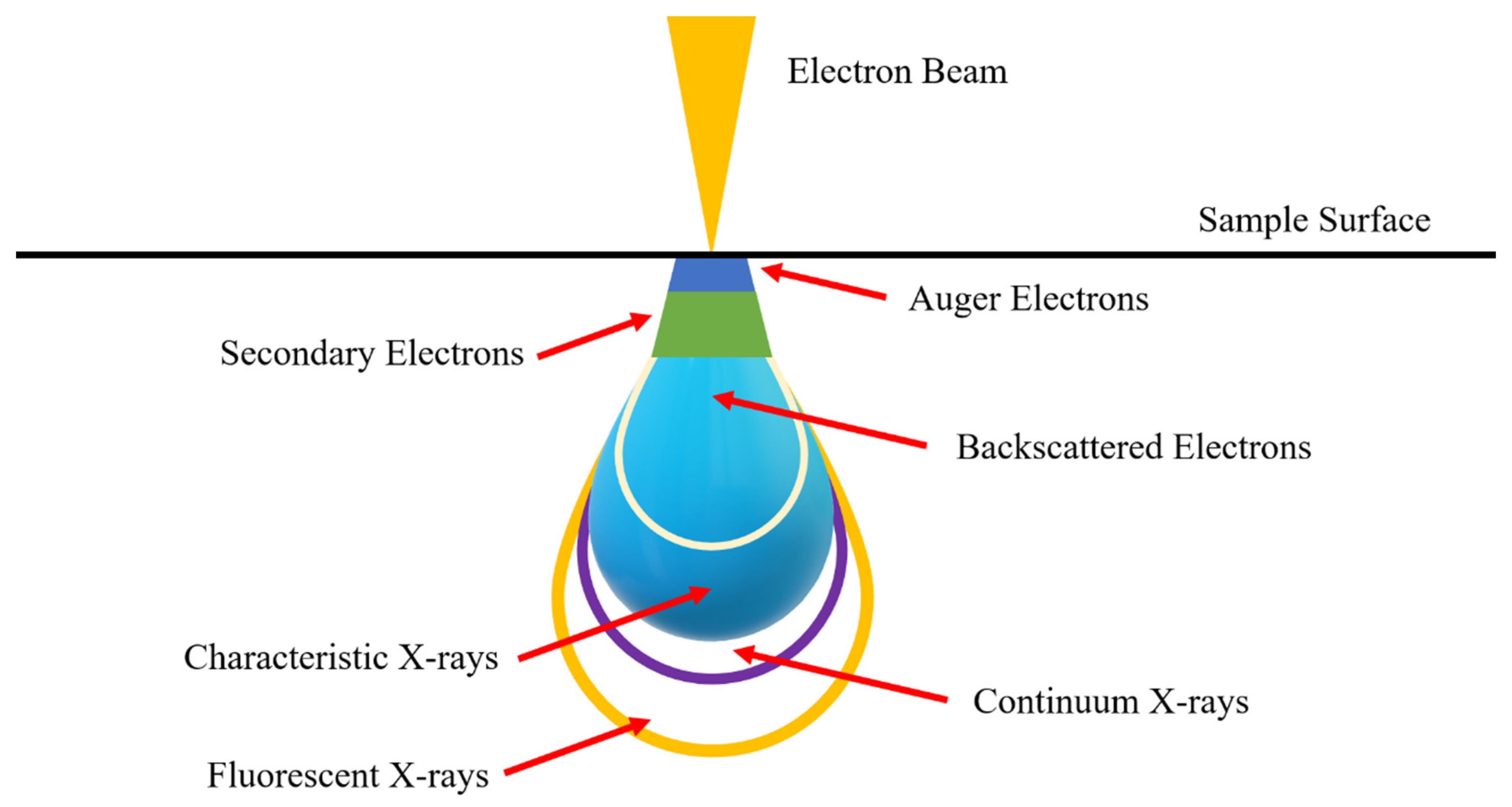
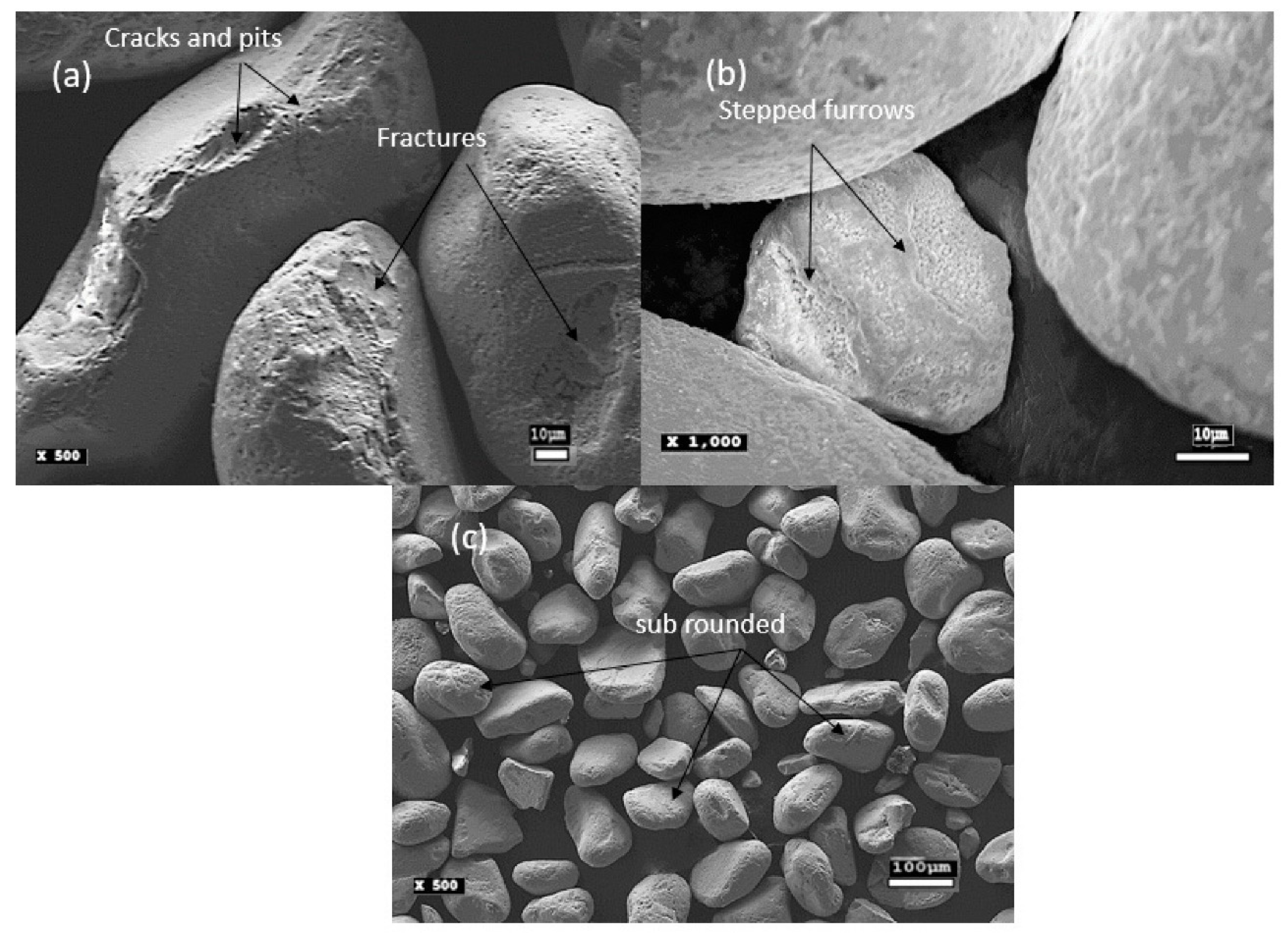
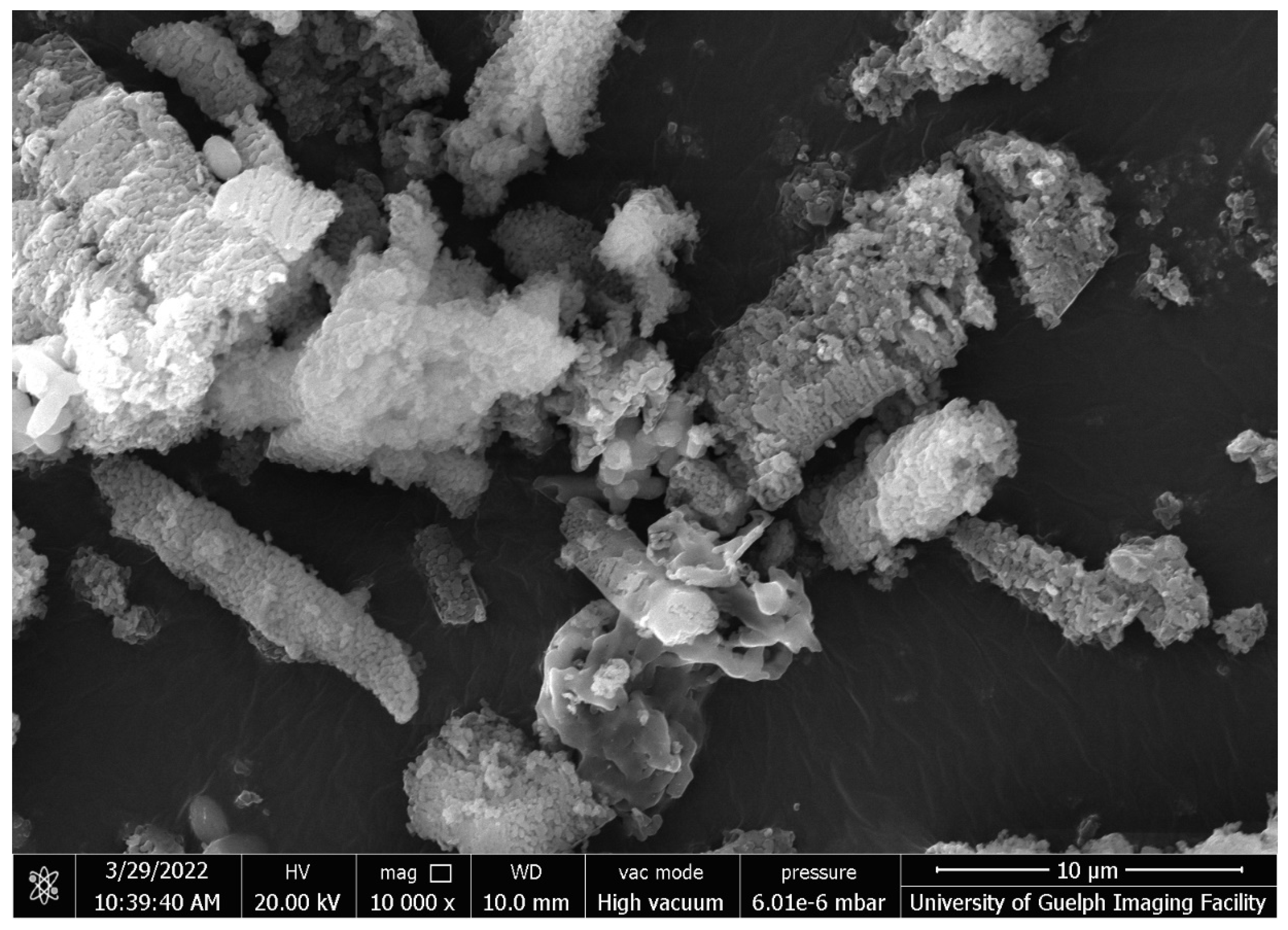
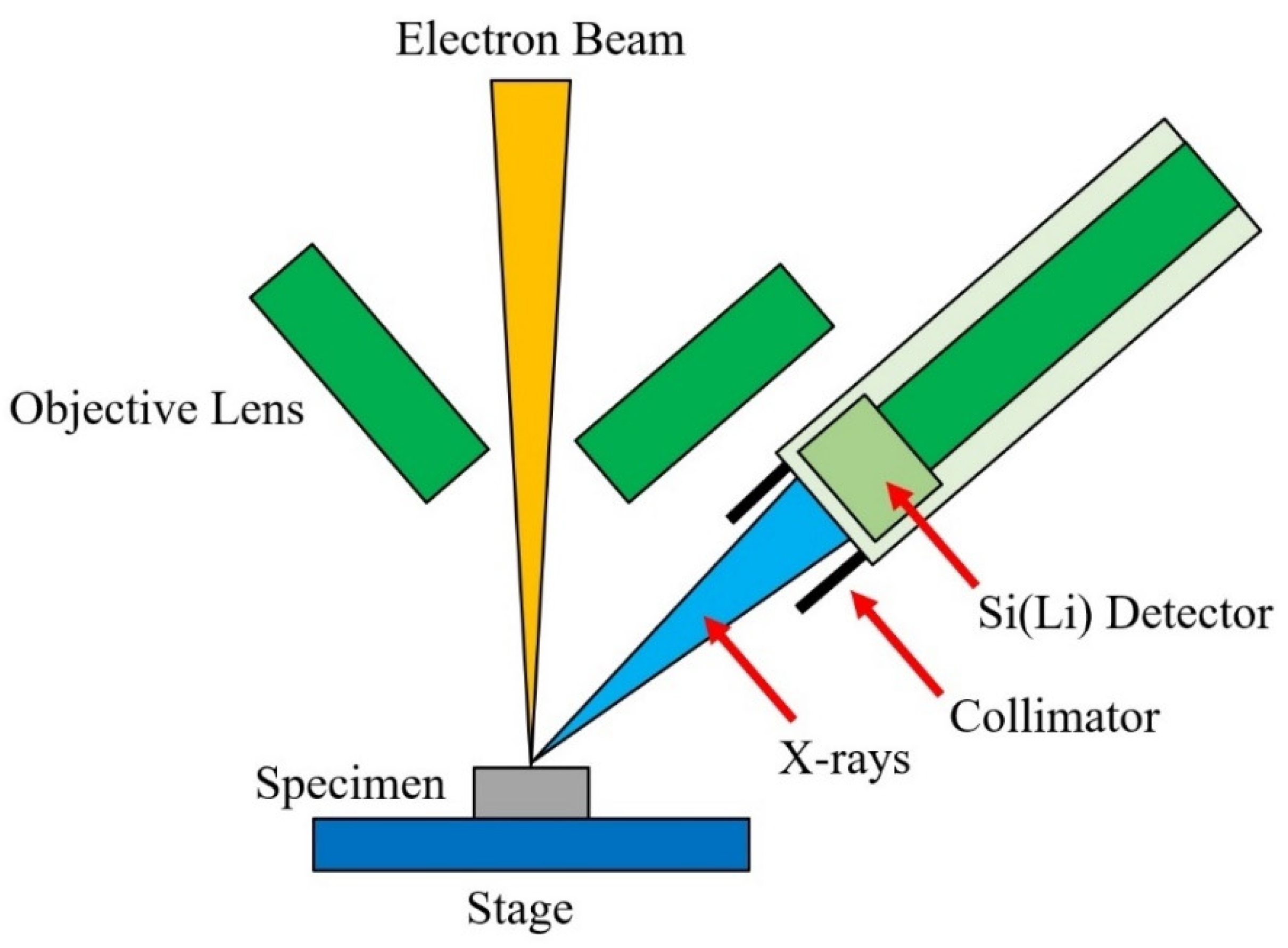
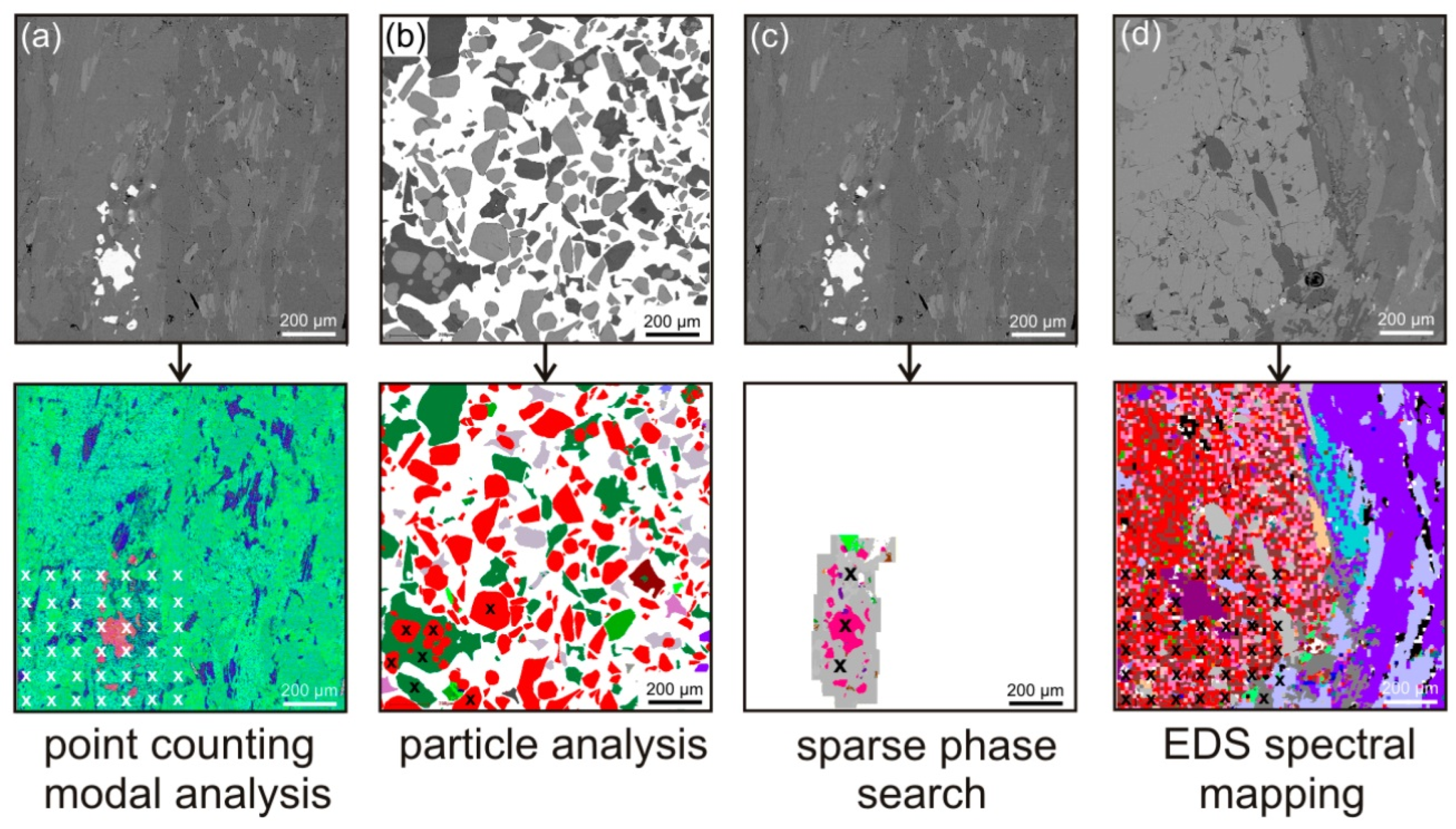
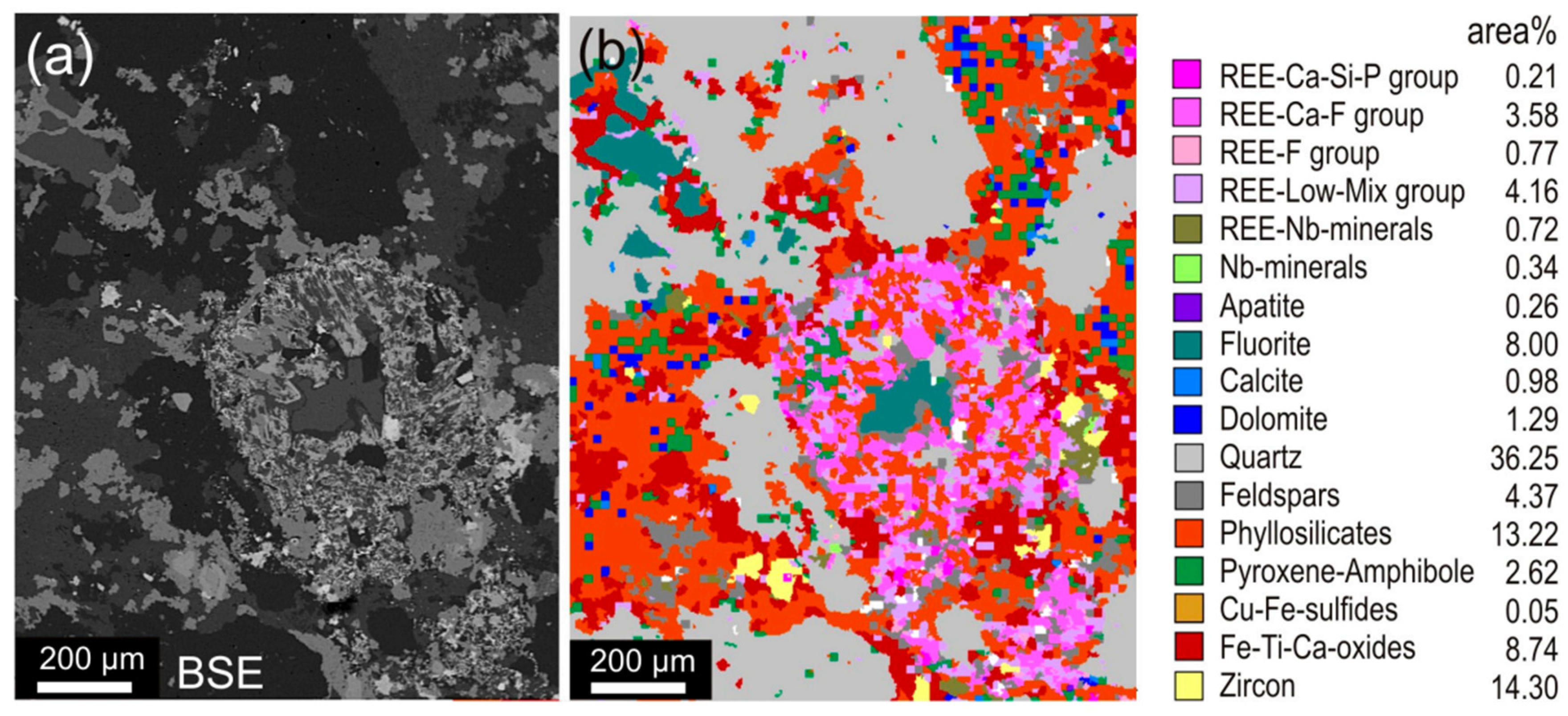
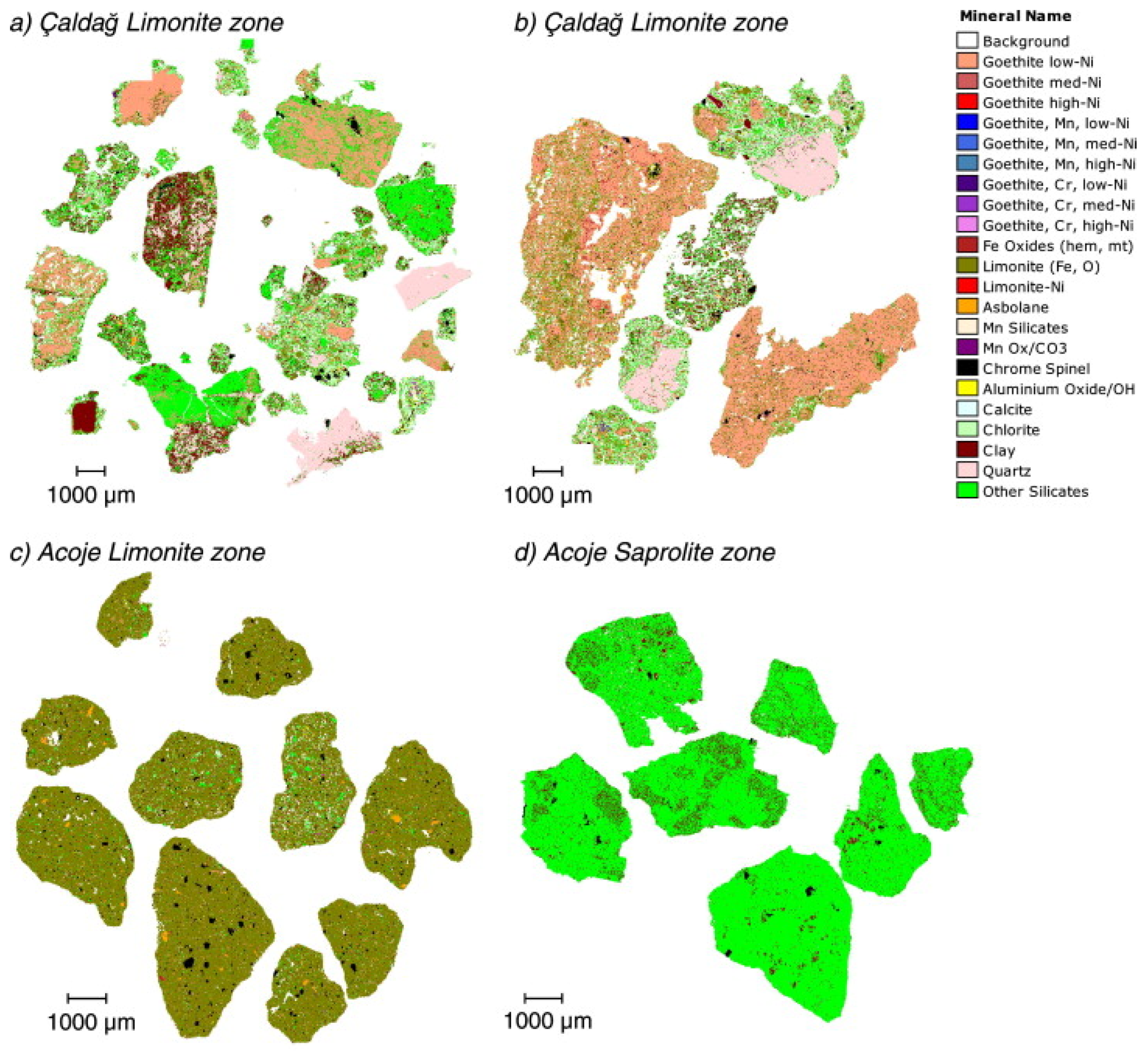
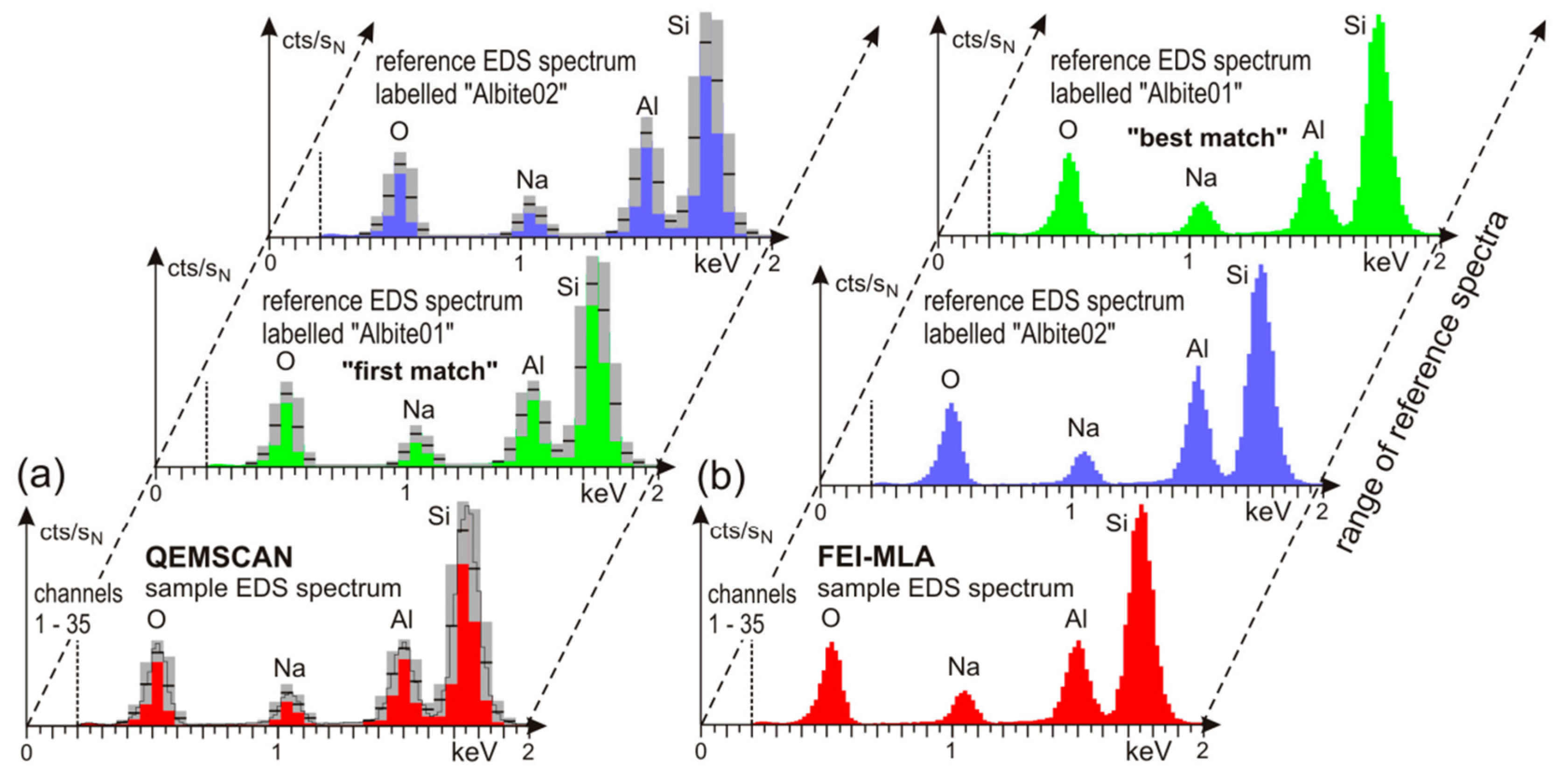
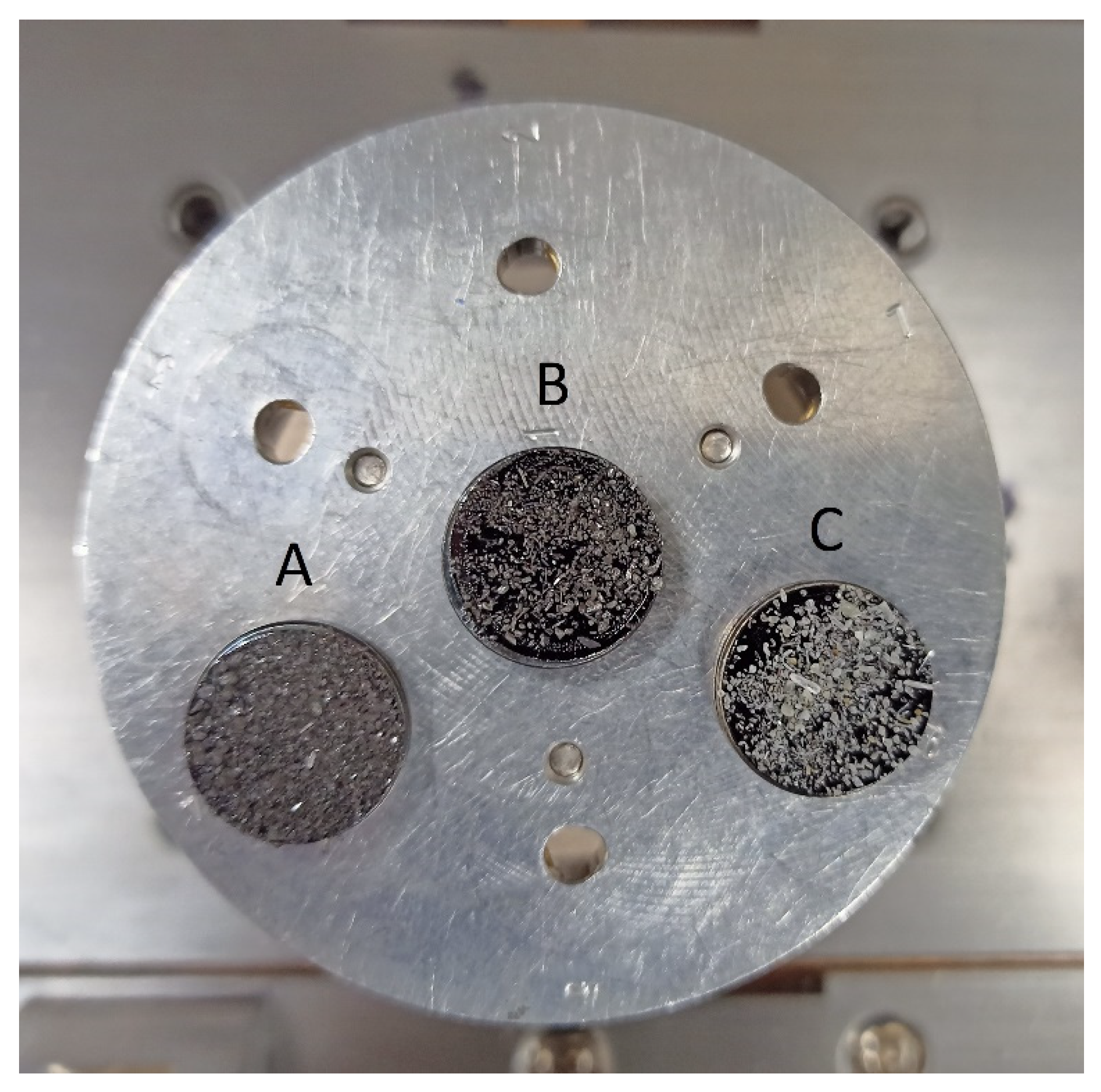
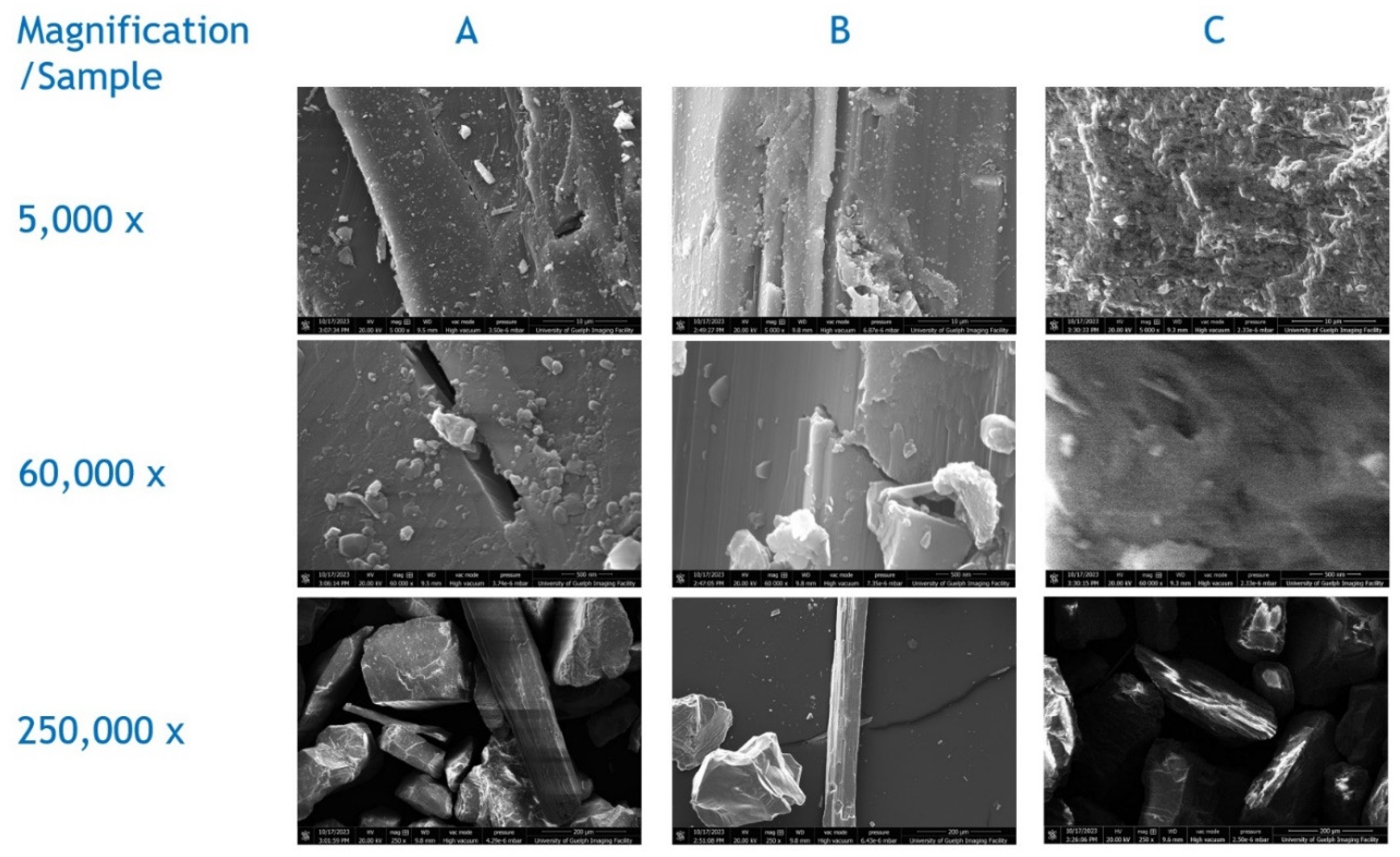
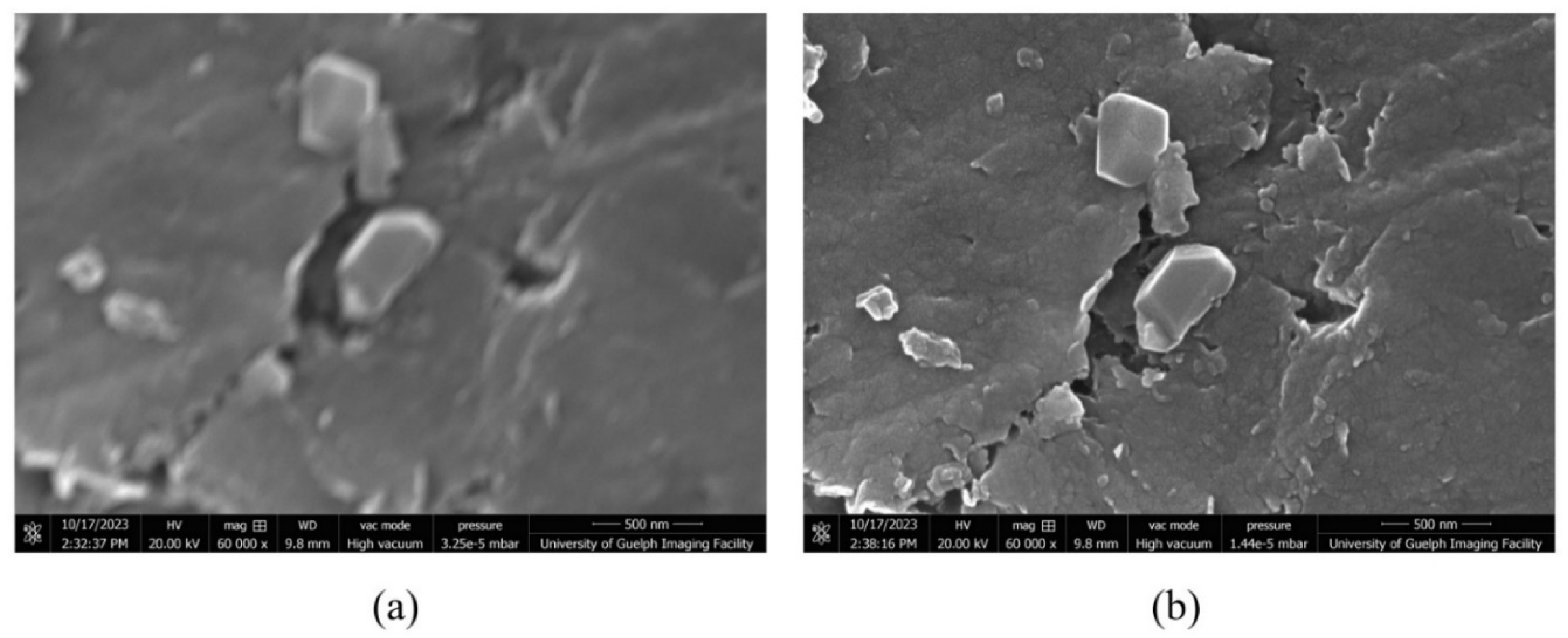
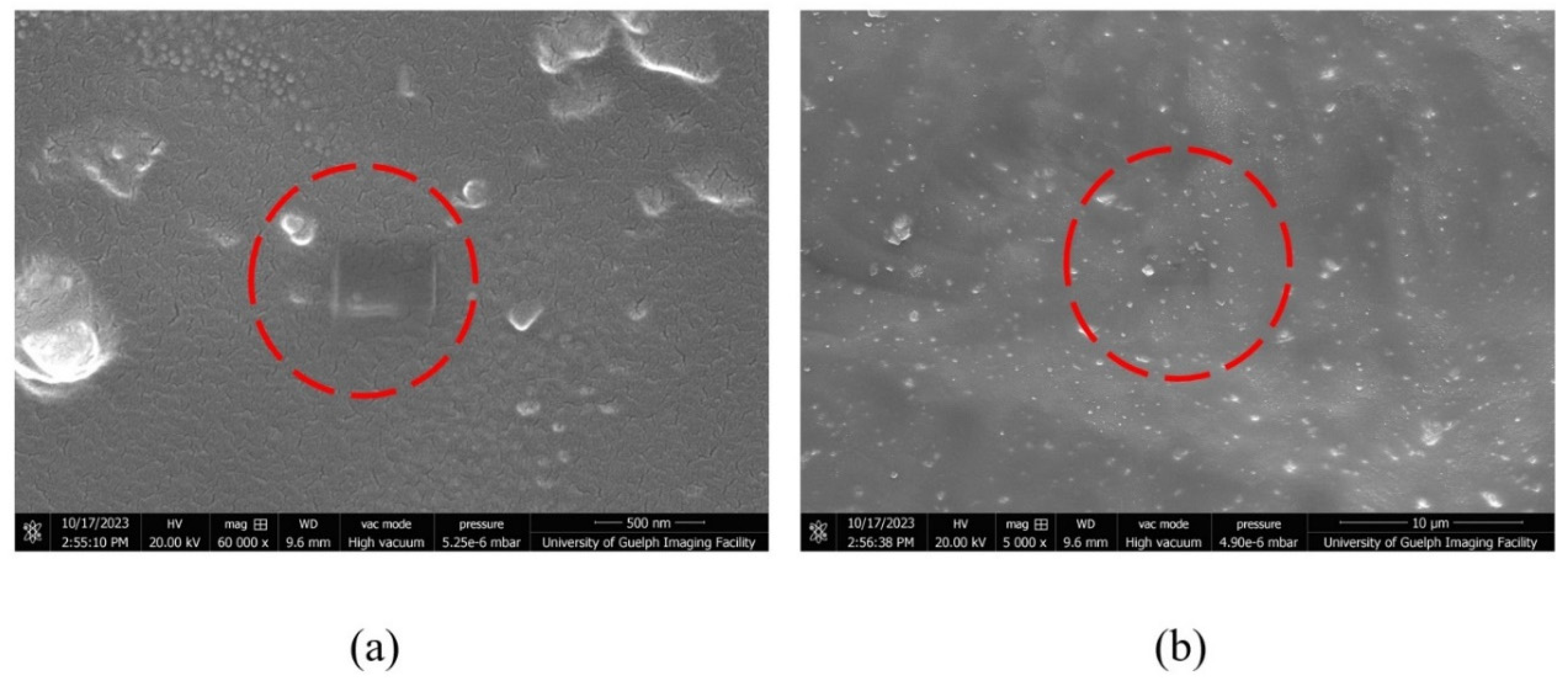
| Analytical Methods / Techniques | Year | Minerals / Materials | Reference |
| SEM/SDD-EDS, EPMA-WDS, | 2023 | Major and minor elements in minerals and rocks | [130] |
| SEM-EDS, XRD | 2022 | Constituent minerals in shales | [131] |
| SEM, TEM | 2018 | Microbial biofilms, Mineral precipitation | [132] |
| SEM-BSE, TMR, SMH | 2018 | Mineral content in enamel lesions | [133] |
| SEM, µXRF, LWIR, SAM | 2020 | Quartz, olivine, kyanite, diopside | [134] |
| SEM-EDS, Raman Spectroscopy | 2019 | Asbestos | [135] |
| SEM-EDX, XPS, XRD, FT-IR, UV | 2020 | Kaolin, Illite, Gibbsite, Quartz | [136] |
| SEM, XRD, TGA, IR, TXRF | 2022 | Mineral constituents in human renal calculi | [137] |
| SEM-FIB | 2021 | Mineralized bone | [138] |
| SEM-EDS | 2021 | Mineralizing fluids, sedimentary brines | [139] |
| SEM-FIB, µCT, XLH | 2020 | Crossfibrillar mineral tessellation | [140] |
| SEM, BSE, EDS, | 2022 | Sandstones | [141] |
| SEM, CT, Raman Spectroscopy | 2021 | Saturated brine, wellbore cement | [142] |
| SEM-EDS, XRD, IRS, XRF | 2023 | Gabbro-anorthosite, seawater, mafic rock | [143] |
| SEM-EDS, AM-SEM, FE-SEM, CT | 2023 | Mineralogical analysis of petroleum geology | [144] |
| SEM-FIB | 2020 | Mineralized scale patterns on the cell periphery | [145] |
| SEM, EMP, Raman Spectroscopy, BSE | 2019 | Petrified wood, Mn-oxide minerals | [146] |
| SEM-EDS, Monte Carlo Simulations | 2021 | Glass fibre-reinforced cement | [147] |
| SEM, XRD, XRF, FTIR | 2022 | High ash coal, fluidized bed gasifier | [148] |
| SEM-EDS, XRD | 2023 | Mineral-forming bacteria | [149] |
| SEM-EDS, XRD, TGA | 2023 | Self-healing cement-based minerals | [150] |
| SEM, XRD, XPS, FTIR | 2023 | Biomimetic mineralized cement | [151] |
| SEM, TEM, PLM, EBSD, SAED | 2023 | Talc, amphiboles, biopyriboles | [152] |
Disclaimer/Publisher’s Note: The statements, opinions and data contained in all publications are solely those of the individual author(s) and contributor(s) and not of MDPI and/or the editor(s). MDPI and/or the editor(s) disclaim responsibility for any injury to people or property resulting from any ideas, methods, instructions or products referred to in the content. |
© 2023 by the authors. Licensee MDPI, Basel, Switzerland. This article is an open access article distributed under the terms and conditions of the Creative Commons Attribution (CC BY) license (http://creativecommons.org/licenses/by/4.0/).





